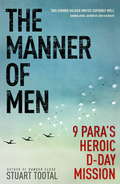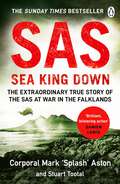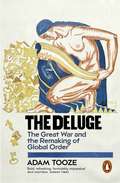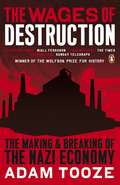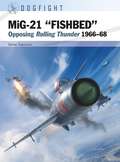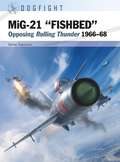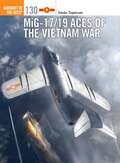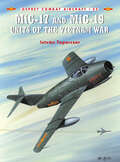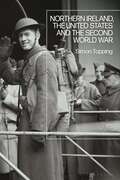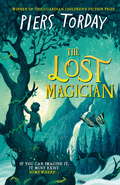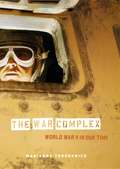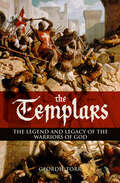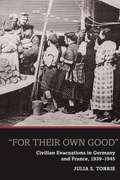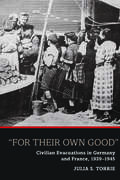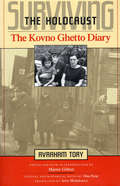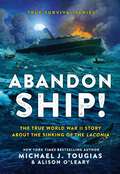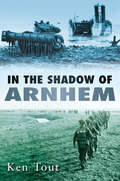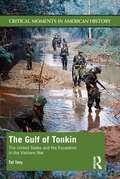- Table View
- List View
The Manner of Men: 9 PARA's Heroic D-Day Mission
by Stuart TootalIn June 1944, an elite unit of British paratroopers was sent on a daring and highly risky behind-the-lines mission, which was deemed vital to the success of D-Day. Dropping ahead of the main Allied invasion, 9 PARA were tasked with destroying an impregnable German gun battery. If they failed, thousands of British troops landing on the beaches were expected to die. But their mission was flawed and started to go wrong from the moment they jumped from their aircraft above Normandy. Only twenty per cent of the unit made it to the objective and half of them were killed or wounded during the attack. Undermanned and lacking equipment and ammunition, the survivors then held a critical part of the invasion beachhead. For six bloody days, they defended the Breville Ridge against vastly superior German forces and bore the brunt of Rommel's attempt to turn the left flank of the Allied invasion.The Manner of Men is an epic account of courage beyond the limits of human endurance, where paratroopers prevailed despite intelligence failures and higher command blunders, in what has been described as one of the most remarkable feat of arms of the British Army and the Parachute Regiment during the Second World War.
SAS: Sea King Down
by Stuart Tootal Mark AstonThe thrilling, edge-of-your-seat true story of one soldier's Special Forces operations in the Falklands War'BRILLIANT. A ROLLERCOASTER OF BLISTERING ACTION, SURVIVAL AND BEHIND-THE-LINES DARING' DAMIEN LEWIS________ After passing the world's toughest Special Forces selection and joining the elite ranks of D Squadron, 22 SAS in 1979, Mark 'Splash' Aston thought the hard part was over. Then on April 2 1982 Argentina invaded the Falkland Islands. Days later D Squadron joined the cutting edge of Britain's campaign to retake the islands. Facing extreme weather and a determined enemy, Splash and the men of D Squadron fought in one extraordinary contact after another. The action never let up. When tragedy struck their Sea King helicopter and it crashed in the freezing South Atlantic, Splash was one of just nine survivors. Evacuated to a hospital ship, Splash defied orders and a suspected broken neck to re-join his unit until the fight was won. An unputdownable, edge-of-the-seat insight into still classified Special Forces operations during the Falklands War, SAS: Sea King Down will take its place alongside classics like Bravo Two Zero as military adventure writing of the highest order.________ 'Gripping, fast moving and completely authentic. A brilliant piece of work. Better than Bravo Two Zero' Mike Rose, former Commanding Officer of the SAS
The Deluge: The Great War and the Remaking of Global Order 1916-1931
by Adam ToozeWINNER OF THE LOS ANGELES TIMES PRIZE FOR HISTORY FINANCIAL TIMES AND NEW STATESMAN BOOKS OF THE YEAR 2014On the centenary of the outbreak of the First World War, Deluge is a powerful explanation of why the war's legacy continues to shape our world - from Adam Tooze, the Wolfson Prize-winning author of The Wages of DestructionIn the depths of the Great War, with millions of dead and no imaginable end to the conflict, societies around the world began to buckle. As the cataclysmic battles continued, a new global order was being born.Adam Tooze's panoramic new book tells a radical, new story of the struggle for global mastery from the battles of the Western Front in 1916 to the Great Depression of the 1930s. The war shook the foundations of political and economic order across Eurasia. Empires that had lasted since the Middle Ages collapsed into ruins. New nations sprang up. Strikes, street-fighting and revolution convulsed much of the world. And beneath the surface turmoil, the war set in motion a deeper and more lasting shift, a transformation that continues to shape the present day: 1916 was the year when world affairs began to revolve around the United States. America was both a uniquely powerful global force: a force that was forward-looking, the focus of hope, money and ideas, and at the same time elusive, unpredictable and in fundamental respects unwilling to confront these unwished for responsibilities. Tooze shows how the fate of effectively the whole of civilization - the British Empire, the future of peace in Europe, the survival of the Weimar Republic, both the Russian and Chinese revolutions and stability in the Pacific - now came to revolve around this new power's fraught relationship with a shockingly changed world. The Deluge is both a brilliantly illuminating exploration of the past and an essential history for the present.
The Wages of Destruction: The Making And Breaking Of The Nazi Economy
by Adam ToozeThis chilling, fascinating new book is the first fully to get to grips with how Hitler's Nazi empire REALLY functioned. There was no aspect of Nazi power untouched by economics - it was Hitler's obsession and the reason the Nazis came to power in the first place. The Second World War was fought, in Hitler's view, to create a European Empire strong enough to take on the United States - a last chance for Europe to dig itself in before being swept away by the USA's ever greater power. But, as THE WAGES OF DESTRUCTION makes clear, Hitler was never remotely strong enough to beat either Britain or the Soviet Union - and never even had a serious plan as to how he might defeat the USA. It took years of fighting and the deaths of millions of people to destroy the Third Reich, but effectively World War II in Europe was fought in pursuit of a fantasy: the years in which Western Europe could settle the world's fate were, by 1939, long past. This is a major book by a major author and will provoke an enormous amount of controversy and debate.
MiG-21 “FISHBED”: Opposing Rolling Thunder 1966–68 (Dogfight #8)
by Dr István ToperczerUsing archival photographs sourced directly from Vietnam, specially commissioned diagrams and combat accounts from veterans, István Toperczer reveals how the MiG-21 defended Vietnam between 1966 and 1968. One of the most successful communist jet fighters ever built, the MiG-21 "Fishbed" was involved in a series of deadly duels with American fighters over North Vietnam as the USAF and US Navy ramped up strike missions during Operation Rolling Thunder, culminating in the destruction of over 70 US aircraft for the loss of 35 "Fishbeds."Having honed their skills on the subsonic MiG-17, pilots of the Vietnam People's Air Force received their first examples of the legendary MiG-21 supersonic fighter in 1966. Soon thrown into combat over North Vietnam, the guided-missile-equipped MiG-21 proved a deadly opponent for the American crews striking at targets deep into communist territory. Although the communist pilots initially struggled to come to terms with the fighter's air search radar and weapons systems, the ceaseless cycle of combat operations quickly honed their skills. The best fighter then available to the VPAF, more than 200 MiG-21s (of various sub-types) were supplied to the North Vietnamese. In this study, leading VPAF authority István Toperczer analyzes the tactics used by the MiG-21 pilots over the bitter fighting in North Vietnam during Rolling Thunder. The highspeed 'hit and run' attacks employed by the communist pilots proved to be very successful, with both R-3S air-to-air missiles and heavy-caliber cannon inflicting a rising toll on American jets. Using first-hand accounts from MiG-21 pilots, battlescene artwork, combat ribbon diagrams, and armament views, the author details the important role played by the "Fishbed" in the defense of North Vietnam.
MiG-21 “FISHBED”: Opposing Rolling Thunder 1966–68 (Dogfight #8)
by Dr István ToperczerUsing archival photographs sourced directly from Vietnam, specially commissioned diagrams and combat accounts from veterans, István Toperczer reveals how the MiG-21 defended Vietnam between 1966 and 1968. One of the most successful communist jet fighters ever built, the MiG-21 "Fishbed" was involved in a series of deadly duels with American fighters over North Vietnam as the USAF and US Navy ramped up strike missions during Operation Rolling Thunder, culminating in the destruction of over 70 US aircraft for the loss of 35 "Fishbeds."Having honed their skills on the subsonic MiG-17, pilots of the Vietnam People's Air Force received their first examples of the legendary MiG-21 supersonic fighter in 1966. Soon thrown into combat over North Vietnam, the guided-missile-equipped MiG-21 proved a deadly opponent for the American crews striking at targets deep into communist territory. Although the communist pilots initially struggled to come to terms with the fighter's air search radar and weapons systems, the ceaseless cycle of combat operations quickly honed their skills. The best fighter then available to the VPAF, more than 200 MiG-21s (of various sub-types) were supplied to the North Vietnamese. In this study, leading VPAF authority István Toperczer analyzes the tactics used by the MiG-21 pilots over the bitter fighting in North Vietnam during Rolling Thunder. The highspeed 'hit and run' attacks employed by the communist pilots proved to be very successful, with both R-3S air-to-air missiles and heavy-caliber cannon inflicting a rising toll on American jets. Using first-hand accounts from MiG-21 pilots, battlescene artwork, combat ribbon diagrams, and armament views, the author details the important role played by the "Fishbed" in the defense of North Vietnam.
MiG-17/19 Aces of the Vietnam War (Aircraft of the Aces)
by István ToperczerAt the beginning of the Vietnam War, the Vietnam People's Air Force (VPAF) were equipped with slow, old Korean War generation fighters – a combination of MiG-17s and MiG-19s – types that should have offered little opposition to the cutting-edge fighter-bombers such as the F-4 Phantom II, F-105 Thunderchief and the F-8 Crusader. Yet when the USAF and US Navy unleashed their aircraft on North Vietnam in 1965 the inexperienced pilots of the VPAF were able to shatter the illusion of US air superiority.Taking advantage of their jet's unequalled low-speed maneuverability, small size and powerful cannon armament they were able to take the fight to their missile-guided opponents, with a number of Vietnamese pilots racking up ace scores. Packed with information previously unavailable in the west and only recently released from archives in Vietnam, this is the first major analysis of the exploits of Vietnamese pilots in the David and Goliath contest with the US over the skies of Vietnam.
MiG-17 and MiG-19 Units of the Vietnam War (Combat Aircraft)
by István ToperczerThe erstwhile enemy of the USAF and US Navy during the nine years of American involvement in the Vietnam War, the Vietnamese Peoples' Air Force (VPAF) quickly grew from an ill-organised rabble of poorly trained pilots flying antiquated communist aircraft into a highly effective fighting force that more than held its own over the skies of North Vietnam. Flying Soviet fighters like the MiG-17, and -19, the VPAF produced over a dozen aces, whilst the Americans managed just two pilots and three navigators in the same period.
Northern Ireland, the United States and the Second World War
by Simon ToppingIn Northern Ireland, The United States and the Second World War, Simon Topping analyses the American military presence in Northern Ireland during the war, examining the role of the government at Stormont in managing this 'friendly invasion', the diplomatic and military rationales for the deployment, the attitude of Americans to their posting, and the effect of the US presence on local sectarian dynamics. He explores US military planning, the hospitality and entertainment provided for American troops, the renewal and reimagining of historic links between Ulster and the United States, the importation of 'Jim Crow' racism, 'Johnny Doughboys' marrying 'Irish Roses', and how all of this impacted upon internal, transatlantic and cross-border politics. This study also draws attention to influential and understudied individuals such as Northern Ireland's Prime Minister Sir Basil Brooke and offers a reassessment of David Gray, America's minister to Dublin. As a result, it provides a comprehensive examination of largely overlooked aspects of the war and Northern Ireland more generally, and fills important gaps in the history of both.Northern Ireland, The United States and the Second World War is essential for students and scholars interested in the history of Northern Ireland, American-Irish relations, the Second World War on the UK home-front, and wartime transatlantic diplomacy.
Northern Ireland, the United States and the Second World War
by Simon ToppingIn Northern Ireland, The United States and the Second World War, Simon Topping analyses the American military presence in Northern Ireland during the war, examining the role of the government at Stormont in managing this 'friendly invasion', the diplomatic and military rationales for the deployment, the attitude of Americans to their posting, and the effect of the US presence on local sectarian dynamics. He explores US military planning, the hospitality and entertainment provided for American troops, the renewal and reimagining of historic links between Ulster and the United States, the importation of 'Jim Crow' racism, 'Johnny Doughboys' marrying 'Irish Roses', and how all of this impacted upon internal, transatlantic and cross-border politics. This study also draws attention to influential and understudied individuals such as Northern Ireland's Prime Minister Sir Basil Brooke and offers a reassessment of David Gray, America's minister to Dublin. As a result, it provides a comprehensive examination of largely overlooked aspects of the war and Northern Ireland more generally, and fills important gaps in the history of both.Northern Ireland, The United States and the Second World War is essential for students and scholars interested in the history of Northern Ireland, American-Irish relations, the Second World War on the UK home-front, and wartime transatlantic diplomacy.
The Frozen Sea
by Piers Torday'If you can imagine it, it exists ... somewhere.' The second incredible instalment of a spellbinding fantasy adventure from the bestselling, award-winning author of The Last Wild trilogy.It is 1984 and forty years since Simon, Patricia and Evelyn and Larry first stepped through a magical library door into the enchanted world of Folio. When Patricia's daughter, Jewel, makes a mysterious discovery in an old bookshop, she begins a quest that will make her question everything she thought she knew. Summoned to Folio, she must rescue her missing aunt, helped only by her rude pet hamster Fizz and a malfunctioning robot.Their mission to the Frozen Sea will bring them face-to-face with a danger both more deadly and more magnificent than they ever imagined.What Jewel discovers will change not just who she thinks she is, but who we all think we are...
The Lost Magician
by Piers Torday'If you can imagine it, it exists ... somewhere.' The new spellbinding fantasy adventure from the bestselling, award-winning author of The Last Wild trilogy.1945. They have survived the Blitz, but when Simon, Patricia, Evelyn and Larry step through a mysterious library door, it is the beginning of their most dangerous adventure yet. They discover the magical world of Folio, where an enchanted kingdom of fairy knights, bears and tree gods is under threat from a sinister robot army. The many stories of the Library are locked in eternal war, and the children's only hope is to find their creator - a magician who has been lost for centuries. What they find will change not just their own lives, but the fate of the world, for ever ...An ode to the world of Narnia, The Lost Magician is a classic in the making from one of the UK's most talented children's authors. Praise for Piers Torday:'the new master of books for children who like magic and modernity with their lust for adventure' - The Times
The War Complex: World War II in Our Time
by Marianna TorgovnickThe recent dedication of the World War II memorial and the sixtieth-anniversary commemoration of D-Day remind us of the hold that World War II still has over America's sense of itself. But the selective process of memory has radically shaped our picture of the conflict. Why else, for instance, was a 1995 Smithsonian exhibition on Hiroshima that was to include photographs of the first atomic bomb victims, along with their testimonials, considered so controversial? And why do we so readily remember the civilian bombings of Britain but not those of Dresden, Hamburg, and Tokyo? Marianna Torgovnick argues that we have lived, since the end of World War II, under the power of a war complex—a set of repressed ideas and impulses that stems from our unresolved attitudes toward the technological acceleration of mass death. This complex has led to gaps and hesitations in public discourse about atrocities committed during the war itself. And it remains an enduring wartime consciousness, one most recently animated on September 11. Showing how different events from World War II became prominent in American cultural memory while others went forgotten or remain hidden in plain sight, The War Complex moves deftly from war films and historical works to television specials and popular magazines to define the image and influence of World War II in our time. Torgovnick also explores the 1961 trial of Adolf Eichmann, the emotional legacy of the Holocaust, and the treatment of World War II's missing history by writers such as W. G. Sebald to reveal the unease we feel at our dependence on those who hold the power of total war. Thinking anew, then, about how we account for war to each other and ourselves, Torgovnick ultimately, and movingly, shows how these anxieties and fears have prepared us to think about September 11 and our current war in Iraq.
The War Complex: World War II in Our Time
by Marianna TorgovnickThe recent dedication of the World War II memorial and the sixtieth-anniversary commemoration of D-Day remind us of the hold that World War II still has over America's sense of itself. But the selective process of memory has radically shaped our picture of the conflict. Why else, for instance, was a 1995 Smithsonian exhibition on Hiroshima that was to include photographs of the first atomic bomb victims, along with their testimonials, considered so controversial? And why do we so readily remember the civilian bombings of Britain but not those of Dresden, Hamburg, and Tokyo? Marianna Torgovnick argues that we have lived, since the end of World War II, under the power of a war complex—a set of repressed ideas and impulses that stems from our unresolved attitudes toward the technological acceleration of mass death. This complex has led to gaps and hesitations in public discourse about atrocities committed during the war itself. And it remains an enduring wartime consciousness, one most recently animated on September 11. Showing how different events from World War II became prominent in American cultural memory while others went forgotten or remain hidden in plain sight, The War Complex moves deftly from war films and historical works to television specials and popular magazines to define the image and influence of World War II in our time. Torgovnick also explores the 1961 trial of Adolf Eichmann, the emotional legacy of the Holocaust, and the treatment of World War II's missing history by writers such as W. G. Sebald to reveal the unease we feel at our dependence on those who hold the power of total war. Thinking anew, then, about how we account for war to each other and ourselves, Torgovnick ultimately, and movingly, shows how these anxieties and fears have prepared us to think about September 11 and our current war in Iraq.
The War Complex: World War II in Our Time
by Marianna TorgovnickThe recent dedication of the World War II memorial and the sixtieth-anniversary commemoration of D-Day remind us of the hold that World War II still has over America's sense of itself. But the selective process of memory has radically shaped our picture of the conflict. Why else, for instance, was a 1995 Smithsonian exhibition on Hiroshima that was to include photographs of the first atomic bomb victims, along with their testimonials, considered so controversial? And why do we so readily remember the civilian bombings of Britain but not those of Dresden, Hamburg, and Tokyo? Marianna Torgovnick argues that we have lived, since the end of World War II, under the power of a war complex—a set of repressed ideas and impulses that stems from our unresolved attitudes toward the technological acceleration of mass death. This complex has led to gaps and hesitations in public discourse about atrocities committed during the war itself. And it remains an enduring wartime consciousness, one most recently animated on September 11. Showing how different events from World War II became prominent in American cultural memory while others went forgotten or remain hidden in plain sight, The War Complex moves deftly from war films and historical works to television specials and popular magazines to define the image and influence of World War II in our time. Torgovnick also explores the 1961 trial of Adolf Eichmann, the emotional legacy of the Holocaust, and the treatment of World War II's missing history by writers such as W. G. Sebald to reveal the unease we feel at our dependence on those who hold the power of total war. Thinking anew, then, about how we account for war to each other and ourselves, Torgovnick ultimately, and movingly, shows how these anxieties and fears have prepared us to think about September 11 and our current war in Iraq.
The War Complex: World War II in Our Time
by Marianna TorgovnickThe recent dedication of the World War II memorial and the sixtieth-anniversary commemoration of D-Day remind us of the hold that World War II still has over America's sense of itself. But the selective process of memory has radically shaped our picture of the conflict. Why else, for instance, was a 1995 Smithsonian exhibition on Hiroshima that was to include photographs of the first atomic bomb victims, along with their testimonials, considered so controversial? And why do we so readily remember the civilian bombings of Britain but not those of Dresden, Hamburg, and Tokyo? Marianna Torgovnick argues that we have lived, since the end of World War II, under the power of a war complex—a set of repressed ideas and impulses that stems from our unresolved attitudes toward the technological acceleration of mass death. This complex has led to gaps and hesitations in public discourse about atrocities committed during the war itself. And it remains an enduring wartime consciousness, one most recently animated on September 11. Showing how different events from World War II became prominent in American cultural memory while others went forgotten or remain hidden in plain sight, The War Complex moves deftly from war films and historical works to television specials and popular magazines to define the image and influence of World War II in our time. Torgovnick also explores the 1961 trial of Adolf Eichmann, the emotional legacy of the Holocaust, and the treatment of World War II's missing history by writers such as W. G. Sebald to reveal the unease we feel at our dependence on those who hold the power of total war. Thinking anew, then, about how we account for war to each other and ourselves, Torgovnick ultimately, and movingly, shows how these anxieties and fears have prepared us to think about September 11 and our current war in Iraq.
The War Complex: World War II in Our Time
by Marianna TorgovnickThe recent dedication of the World War II memorial and the sixtieth-anniversary commemoration of D-Day remind us of the hold that World War II still has over America's sense of itself. But the selective process of memory has radically shaped our picture of the conflict. Why else, for instance, was a 1995 Smithsonian exhibition on Hiroshima that was to include photographs of the first atomic bomb victims, along with their testimonials, considered so controversial? And why do we so readily remember the civilian bombings of Britain but not those of Dresden, Hamburg, and Tokyo? Marianna Torgovnick argues that we have lived, since the end of World War II, under the power of a war complex—a set of repressed ideas and impulses that stems from our unresolved attitudes toward the technological acceleration of mass death. This complex has led to gaps and hesitations in public discourse about atrocities committed during the war itself. And it remains an enduring wartime consciousness, one most recently animated on September 11. Showing how different events from World War II became prominent in American cultural memory while others went forgotten or remain hidden in plain sight, The War Complex moves deftly from war films and historical works to television specials and popular magazines to define the image and influence of World War II in our time. Torgovnick also explores the 1961 trial of Adolf Eichmann, the emotional legacy of the Holocaust, and the treatment of World War II's missing history by writers such as W. G. Sebald to reveal the unease we feel at our dependence on those who hold the power of total war. Thinking anew, then, about how we account for war to each other and ourselves, Torgovnick ultimately, and movingly, shows how these anxieties and fears have prepared us to think about September 11 and our current war in Iraq.
The War Complex: World War II in Our Time
by Marianna TorgovnickThe recent dedication of the World War II memorial and the sixtieth-anniversary commemoration of D-Day remind us of the hold that World War II still has over America's sense of itself. But the selective process of memory has radically shaped our picture of the conflict. Why else, for instance, was a 1995 Smithsonian exhibition on Hiroshima that was to include photographs of the first atomic bomb victims, along with their testimonials, considered so controversial? And why do we so readily remember the civilian bombings of Britain but not those of Dresden, Hamburg, and Tokyo? Marianna Torgovnick argues that we have lived, since the end of World War II, under the power of a war complex—a set of repressed ideas and impulses that stems from our unresolved attitudes toward the technological acceleration of mass death. This complex has led to gaps and hesitations in public discourse about atrocities committed during the war itself. And it remains an enduring wartime consciousness, one most recently animated on September 11. Showing how different events from World War II became prominent in American cultural memory while others went forgotten or remain hidden in plain sight, The War Complex moves deftly from war films and historical works to television specials and popular magazines to define the image and influence of World War II in our time. Torgovnick also explores the 1961 trial of Adolf Eichmann, the emotional legacy of the Holocaust, and the treatment of World War II's missing history by writers such as W. G. Sebald to reveal the unease we feel at our dependence on those who hold the power of total war. Thinking anew, then, about how we account for war to each other and ourselves, Torgovnick ultimately, and movingly, shows how these anxieties and fears have prepared us to think about September 11 and our current war in Iraq.
The Templars: The Legend and Legacy of the Warriors of God
by Geordie TorrShrouded in myth and conspiracy, the history of the Knights Templar is little understood. Geordie Torr pulls fact from fiction, revealing the astonishing tale of this military-religious order that dominated the politics of the medieval Middle East. Initially created to protect Christian pilgrims to the Holy Land in the wake of the First Crusade, the Templars soon became an institution of incredible power, possessing wealth and influence throughout the courts of Europe. Yet just two centuries later they dramatically fell as its members were accused of heresy and burned at the stake, though some were believed to have survive and secretly kept serving God. Clearly and chronologically written, this illustrated book brings to life the legacy of this secretive order and the characters who defined the era, making it an informative and enjoyable read.
'For Their Own Good': Civilian Evacuations in Germany and France, 1939-1945
by Julia S. TorrieThe early twentieth-century advent of aerial bombing made successful evacuations essential to any war effort, but ordinary people resented them deeply. Based on extensive archival research in Germany and France, this is the first broad, comparative study of civilian evacuations in Germany and France during World War II. The evidence uncovered exposes the complexities of an assumed monolithic and all-powerful Nazi state by showing that citizens' objections to evacuations, which were rooted in family concerns, forced changes in policy. Drawing attention to the interaction between the Germans and French throughout World War II, this book shows how policies in each country were shaped by events in the other. A truly cross-national comparison in a field dominated by accounts of one country or the other, this book provides a unique historical context for addressing current concerns about the impact of air raids and military occupations on civilians.
'For Their Own Good': Civilian Evacuations in Germany and France, 1939-1945
by Julia S. TorrieThe early twentieth-century advent of aerial bombing made successful evacuations essential to any war effort, but ordinary people resented them deeply. Based on extensive archival research in Germany and France, this is the first broad, comparative study of civilian evacuations in Germany and France during World War II. The evidence uncovered exposes the complexities of an assumed monolithic and all-powerful Nazi state by showing that citizens' objections to evacuations, which were rooted in family concerns, forced changes in policy. Drawing attention to the interaction between the Germans and French throughout World War II, this book shows how policies in each country were shaped by events in the other. A truly cross-national comparison in a field dominated by accounts of one country or the other, this book provides a unique historical context for addressing current concerns about the impact of air raids and military occupations on civilians.
Surviving the Holocaust The Kovno Ghetto Diary
by Avraham ToryThis remarkable chronicle of life and death in the Jewish Ghetto of Kovno, Lithuania, incorporates Avraham Tory’s collections of official documents, Jewish Council reports, and original photographs and drawings. Gilbert’s introduction supplies the backdrop of the war in Europe, considering crucial questions of collaboration and resistance.
Abandon Ship!: The True World War II Story About the Sinking of the Laconia (True Survival Series #1)
by Michael J. Tougias Alison O'LearyA remarkable World War II account of a maritime attack off the West African coast, for fans of Steven Sheinkin and Deborah Heiligman. At the height of World War II, the RMS Laconia was torpedoed by a German submarine five hundred miles off the coast of western Africa. The attack triggered a series of unprecedented events involving allies and enemies from both sides, and left survivors adrift at sea in shark infested oceans, fighting to stay alive with little food or water. Suspenseful and informative, and featuring historic photographs, this incredible true account is a testament to the idea that compassion can rule over conflict—even during the cruelties of war. A Junior Library Guild Gold Standard Selection "This epic story races along, unspooling like a movie before our eyes—artfully, dramatically, revealing a little known part of WWII history. An intriguing book."―Doug Stanton, #1 New York Times bestselling author of In Harm&’s Way "The authors do an excellent job of conveying the chaos and loss of this grisly historical incident without pushing young readers too deeply into the horror. Many of those who lived through the Laconia catastrophe endured weeks at sea, parched and sunburned and starving in conditions that literally drove men mad. Archival photos add immediacy to this sensational true-life story." ―Wall Street Journal "An amazing account of a World War II event that is almost entirely unknown…. This story chronicles the courage, compassion, and perseverance of the few survivors of the incident, showcasing war at its worst and humanity at its best…. School librarians will want to add this to their collection." ―Booklist
In the Shadow of Arnhem: The Battle For The Lower Maas, Steptember - November 1944
by Ken ToutThe Battle of Arnhem in September 1944 has been much publicised, with its extraordinary parachute drop and gallant defence by Frost's few men of the bridge at Arnhem. Although the campaign came close to success, its relative failure left the Allies trapped within a thirty-mile stretch of road. The Arnhem debacle saw vast stretches of Holland to the left and right of the salient occupied by enemy forces. These areas of Holland, criss-crossed by unfordable rivers and closely populated by small villages, had to be cleared by Allied troops in platoon or company strength, fighting in tight situations against bitter skilled resistance. There was none of the awesome and inspirational massing of troops seen in the battle of Normandy, for Arnhem itself. Interweaving his engaging narrative style with the eyewitness accounts and personal reminiscences of British, Canadian and Polish troops, Ken Tout reveals how these men performed their heroic deeds. They suffered and died in unheralded, largely forgotten minor skirmishes, but on a scale far exceeding the casualties of the immediate assault on Arnhem. They deserve to be remembered. This is their story.
The Gulf of Tonkin: The United States and the Escalation in the Vietnam War (Critical Moments in American History)
by Tal TovyThe Gulf of Tonkin: The United States and the Escalation in the Vietnam War analyzes the events that led to the escalation of the conflict in Vietnam and increased American involvement. On August 4, 1964, the captains of two American destroyers, the USS Maddox and the USS Turner Joy, reported that their ships were being attacked by North Vietnamese torpedo boats. This report came on top of a previous report by the captain of the USS Maddox, indicating that he had been attacked by torpedo boats two nights earlier. The text introduces readers to the historiography of these incidents and how the perception of the events changed over time. The attacks, which were collectively called the Gulf of Tonkin incident, are presented in the context not only of the Vietnam War but also of the Cold War and U.S. government powers, enabling students to understand the events’ full ramifications. Using essential primary documents, Tal Tovy provides an accessible introduction to a vital turning point in U.S. and international affairs. This book will be useful to all students of the Vietnam War, American military history, and foreign policy history.
